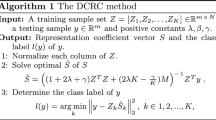Abstract
Representation-based classification methods have brought into sharp focus in recent years and achieved better classification performance. Both collaborative representation-based classification (CRC) algorithm and linear regression classification (LRC) algorithm are two typical representation-based classification methods. However, patterns from a single object are requested to lie on a linear subspace in representation-based classification methods. There are not enough samples in reality for face recognition, and it is difficult for the limited data to meet the requirement. The mirror images and the inverse images of the original images are still an effective description of the face. The problem of insufficient sample can be solved well by means of mirror image and inverse image. Based on this idea, a novel fusion linear representation-based classification method is proposed in the paper. The mirror image of each training sample is firstly generated, and the original training samples and the new obtained mirror images corresponding to the original training sample images are used for acting as training set for LRC. Then, the inverse image of each image is generated and the inverse training images are used to perform CRC. Lastly, the score-level fusion scheme is taken to complete classification task. The extensive experiment results on four public image databases clearly indicate that our method has very competitive classification results.











Similar content being viewed by others
References
Abdullah MFA, Sayeed MS et al (2014) Face recognition with symmetric local graph structure (SLGS). Expert Syst Appl 41(14,15):6131–6137
Ekman P, Hager JC, Friesen WV (1981) The symmetry of emotional and deliberate facial actions. Psychophysiology 18(2):101–106
Hermosilla G, Ruiz-del-Solar J et al (2012) A comparative study of thermal face recognition methods in unconstrained environments. Pattern Recognit 45(7):2445–2459
Krisshna NLA, Deepak VK et al (2014) Face recognition using transform domain feature extraction and PSO-based feature selection. Appl Soft Comput 22:141–161
Lai Z, Yong X, Yang J, Tang J, Zhang D (2013) Sparse tensor discriminant analysis. IEEE Trans Image Process 22(10):3904–3915
Levine MD, Yingfeng Y (2006) Face recognition subject to variations in facial expression, illumination and pose using correlation filters. Comput Vis Image Underst 104(1):1–15
Mairal J, Bach F, Ponce J, Sapiro G, Zisserman A (2008) Supervised dictionary learning. In: Proceedings of the conference on advances in neural information processing systems, pp 1033–1040
Naseem I, Togneri R et al (2010a) Linear regression for face recognition. IEEE Trans Pattern Anal Mach Intell 32(11):2106–2112
Naseem I, Togneri R et al (2010b) Robust regression for face recognition. In: International conference on pattern recognition, pp 1156–1159
Peng X, Zhiding Y et al (2017) Constructing the L2-graph for robust subspace learning and subspace clustering. IEEE Trans Cybern 47(4):1053–1066
Phillips PJ, Wechsler H et al (1998) The FERET database and evaluation procedure for face-recognition algorithms. Image Vis Comput 16(5):295–306
Saha S, Bandyopadhyay S (2007) A symmetry based face detection technique. In: Proceedings of the IEEE WIE national symposium on emerging technologies, pp 1–4
Samaria F, Harter A (1994) Parameterisation of a stochastic model for human face identification. In: Second IEEE workshop on applications of computer vision, Sarasota
Shi Y, Dai DQ, Liu CC, Yan H (2009) Sparse discriminant analysis for breast cancer biomarker identification and classification. Prog Nat Sci 19(11):1635–1641
Shi Q, Eriksson A, Hengel A, Shen C (2011) Is face recognition really a compressive sensing problem? In: CVPR, pp 553–560
Wright J, Yang AY, Ganesh A, Sastry SS, Ma Y (2009) Robust face recognition via sparse representation. IEEE Trans Pattern Anal Mach Intell 31(2):210–227
Wright J, Ma Y, Mairal J, Sapiro G, Huang TS, Yan S (2010) Sparse representation for computer vision and pattern recognition. Proc IEEE 98(6):1031–1044
Wu J, Pan S, Zhu X, Zhang P, Zhang C (2016) SODE: self-adaptive one-dependence estimators for classification. Pattern Recognit 51:358–377
Wu J, Pan S, Zhu X, Zhang C, Wu X (2017) Positive and unlabeled multi-graph learning. IEEE Trans Cybern 47(4):818–829
Xu Y, Zhang D, Yang J, Yang J-Y (2011a) A two-phase test sample sparse representation method for use with face recognition. IEEE Trans Circuits Syst Video Technol 21(9):1255–1262
Xu Y, Zhu Q (2013) A simple and fast representation-based face recognition method. Neural Comput Appl 22(7–8):1543–1549
Xu Y, Zhu X et al (2013) Using the original and ‘symmetrical face’ training samples to perform representation based two-step face recognition. Pattern Recognit 46:1151–1158
Xu Y, Zuo W, Fan Z (2011b) Supervised sparse presentation method with a heuristic strategy and face recognition experiments. Neurocomputing 79:125–131
Yang J, Zhang L, Xu Y, Yang J-Y (2012) Beyond sparsity: the role of L1-optimizer in pattern classification. Pattern Recognit 45:1104–1118
Yong X, Zhu Q, Fan Z, Zhang D, Mi J, Lai Z (2013) Using the idea of the sparse representation to perform coarse to fine face recognition. Inf Sci 238:138–148
Yong X, Xuelong L, Jian Y, Zhihui L, David Z (2014) Integrating conventional and inverse representation for face recognition. IEEE Trans Cybern 44(10):1738–1746
Zhang L et al (2011) Sparse representation or collaborative representation: which helps face recognition?. In: ICCV, pp 1–8
Zhang Z, Li F, Zhao M (2017) Robust neighborhood preserving projection by nuclear/L2, 1-norm regularization for image feature extraction. IEEE Trans Image Process 26(4):1607–1622
Zhu W, Yan Y, Peng Y (2016) Dictionary learning based on discriminative energy contribution for image classification. Knowl Based Syst 113:116–124
Acknowledgements
This work was partly supported by NSFC of China (U1504610), the Natural Science Foundations of Henan Province (14A413013, 142102210584, 18A120002), the Development Foundations of Henan University of Science and Technology (2014ZCX013).
Author information
Authors and Affiliations
Corresponding author
Ethics declarations
Conflict of interest
No conflict of interest exists in the submission of this manuscript, and the manuscript is approved by all authors for publication.
Ethical approval
This article does not contain any studies with animals performed by any of the authors.
Additional information
Communicated by V. Loia.
Rights and permissions
About this article
Cite this article
Liu, Z., Xie, G., Zhang, L. et al. Fusion linear representation-based classification. Soft Comput 23, 1891–1899 (2019). https://doi.org/10.1007/s00500-017-2898-7
Published:
Issue Date:
DOI: https://doi.org/10.1007/s00500-017-2898-7




